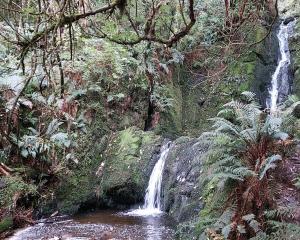Dunedin's Ocean Beach Domain is the frontline in an ongoing battle between sea and land that has serious implications for the low-lying suburbs behind the dunes. The forces at work, not least the hand of man, have shaped a significantly modified environment.
Change has been brought about by the pressure for raw resources in a developing city, the introduction of marram grass and ultimately the need to tame the coast for the physical protection of the city.
There are lessons here for those who are prepared to look at the mistakes of the past, say Paul Pope, of the Dunedin Amenities Society, and the late John Perry.
• Kaituna
Ocean Beach is a highly modified environment. The normal activity and movement of sand has been altered in favour of a more stable landscape. The former back-dune areas have been extensively mined and become recreation areas.
The coastline still stretches from the St Clair cliffs in the west to Lawyers Head in the east, but the sand dunes have become much thinner and steeper.
In 1848 in the west around St Clair, the sand hills were much smaller and lower, and the mouth of a lagoon ran through these dunes. They accumulated and grew as you moved east towards Lawyers Head.
High ground was in the west at the St Clair hills and in the east at the beginning of Otago Peninsula and beyond them, Otago Harbour and its extended tidal areas.
Between these features was a low-lying wetland named Kaituna. It was covered with silver tussock, rushes and flax and was an area of traditional food-gathering for Maori who sought tuna (eel), pukeko and weka.
There is also evidence that the Kaituna area was once thick with trees, probably kahikatea. They lay buried under the surface of the wetland and were often dug up and used as firewood by early settlers.
A significant feature was a track along the landward edge of the sand hills, which provided easy access to Kaituna.
By 1876 the urban growth of Dunedin had pushed housing to the edge of the sand hills at Ocean Beach. Sand was being removed constantly by householders to raise the level of their sections. Occasional floods are reported in the 1870s, but mostly from the harbour, into South Dunedin.
On one occasion a Mrs Rae and her two daughters were rescued by a gasworks boat crew from Rankeilor St. Their dog was reportedly left behind.
The coachbuilder for Cobb & Co in Reid Rd built a flat-bottomed boat in which he used to paddle to the nearest dry land in times of flood. There was once reported nine inches of water in the Hillside Railway Workshops wagon shop that stopped work for several days.
• Blunderbuss or horse pistol
With urban growth came the development of the railways and in 1880 Edward Pritchard won a government contract to shift sand from the Ocean Beach dunes to use as fill at the railway yards development at Crawford and Cumberland streets.
Mr Pritchard laid an extension of the railway line in the St Kilda Borough from the crescent to the sand hills in January 1880. However, permission from the appropriate borough council had not been obtained.
St Kilda Mayor J. P. Jones was indignant and he "vehemently objected entirely to the whole proceeding".
"It would never do to allow 50 acres of filling to be taken from the sand hills, which were all the protection St Kilda had from the strong winds and the encroachment of the sea," he said.
The result was that the St Kilda dayman, with the help of mayor and councillors, took up the rails the next morning.
The following day the Otago Daily Times reported that Mr Pritchard had imported an American steam excavator. The massive and powerful steam crane weighed 37 tons, and was to be "fitted up and put to work at the sand hills without delay".
Mr Pritchard was not going to be thwarted by the St Kilda Borough Council. As is customary in local politics a crisis public meeting of the St Kilda ratepayers was held on March 9, 1880. The council chamber was full.
Mayor Jones reported that he had remonstrated with the Minister of Public Works James Macandrew, who agreed that probably the engineer had been mistaken in his advice and promised to look into the matter.
Nothing more was heard until the announcement that Pritchard & Co had been awarded the contract to remove the sand.
St Kilda Borough Council received a report from civil engineer George Barr who opposed the removal of the sand and gave an insightful and accurate account of the effects of stripping the Ocean Beach dunes.
"The dangers of interfering with sands of so mobile a nature as these has long been recognised, because it is found that so soon as the surface vegetation is broken upon, the wind acts freely upon the sand, carrying it in quantities and to distances dependent, of course, upon the strength, duration and frequency of the winds. Once such an evil sets in, it is impossible to foretell its extent, and the only mode of checking it is replanting ..."
He went on further to describe the nature of the area and its perilous position below sea level.
"In 1874 I ascertained that ... some portions of the Flat are actually three feet lower than the high water of Ocean Beach. These facts point out then that the sand hills ... are really a natural and necessary protection to the low-lying lands against the encroachments of the ocean ..."
The Government was in a difficult position as it had already let the contract to Pritchard and needed the fill to continue with the development of the city's railways. The government engineer, W. N. Blair, wrote to the St Kilda Borough reiterating the government position and issuing a threat.
"The parties who interfered with the rails might be summarily dealt with. I trust, therefore, that the Corporation of St Kilda will assist the Government in carrying out the work by giving free use of the streets."
The St Kilda Borough Council was condemned in the Otago Daily Times on March 11 for interfering with the rails. The same day, Mr Pritchard again laid more rails across St Kilda streets.
Two days later Mayor Jones, councillors and the dayman of St Kilda lifted them and put them in an adjoining paddock.
Public condemnation in the press drove Mayor Jones to paper, and in a letter to the Otago Daily Times editor he wrote: "Anything which tends to do away with the small hills endangers the first protection, and thus not only endangers the property, but also the lives of the residents of the Flat. It is impossible to say how soon both lives and property may be swamped in one common ruin".
Here the matter gets more frenetic.
On March 16 the Crown gave St Kilda Borough notice pursuant to the Public Works Act of its intentions to construct the railway and take the sand.
On March 23, the council met and resolved to give its own notice that the work should not proceed.
Next, on April 28, Mr Pritchard was charged in the Police Court on the information of Mr Jones that on April 23, "without authorisation by the Council or any act or ordinance, unlawfully obstructed streets by leaving in Victoria Street timber and rails contrary to section 189 of the Municipal Corporation Act 1876". The decision was reserved.
Finally, the mayor and 340 other inhabitants of St Kilda petitioned the Government, requesting that the House take steps against the removal of sand as proposed by the Public Works Department, as it was likely to threaten serious injury to property.
The petition was considered by the Waste Lands Committee which reported back to the House "the matter is one for the Government to deal with and the responsibility is theirs".
Incredibly, the Government ordered that the sand must be taken only from the seaward side of the hills. Mr Pritchard demanded compensation for the longer carriage of sand, which was refused.
Soon though, he commenced work at the old site, only to have the supervising government engineer, Mr Low, order the railway engine crews (government servants) to cease work. In a fury, Mr Pritchard fired them all and hired his own men.
The government railwaymen then tried to take possession of the engines, there was a scuffle on the footplate and the government men were driven off.
Later, Mr Low in the dead of night brought another engine up to tow away the engines being used by Mr Pritchard, now stored in a shed. Mr Pritchard heard of the scheme and lifted the rails leading up to the shed.
The government men, foiled in their purpose, broke into the shed anyway only to be met by Mr Pritchard who was described in the Otago Daily Times as being "... armed for the fray with a blunderbuss or horse pistol".
The government railwaymen beat a hasty retreat. Now it was time for legal action.
On April 14, 1881, the Commissioner of Crown Lands sued Mr Pritchard in the Supreme Court for recovery of 500 for trespass and damages arising from his removal of sand from parts of the sand dunes other than as directed by the supervising engineers.
Mr Pritchard contended that his contract was not specific about the place from which the sand should be taken.
The judge agreed: "They may have control over the works, but they have no power to alter the construction of the contract and as there was no limit in the contract, Mr Pritchard could go where he pleased".
Mr Pritchard continued with his contract, excavating where he chose. The damage had been done.
Between 1884 and 1886 the St Clair sea wall and esplanade was undermined and destroyed by heavy seas. Further flooding occurred between 1884 and 1894.
In May 1898 the dunes were breached and there was almost a metre of water in Larkworthy St. By May 11 all of St Kilda between Ocean Beach Domain and Cargills Rd was inundated. In July the sea breached the dunes again and St Kilda was again saturated.
The passing of the Ocean Beach Public Domain Act in 1892 provided for the protection and conservation of the area known as the sand hills.
However, this was a period of public acrimony and recrimination that, coupled with public alarm, rendered the Ocean Beach Domain Board largely ineffectual. It was not until J. H. Hancock became chairman in 1902 that prolonged periods of restoration and recreation development occurred.
• Conclusions
It seems incredible now that the Government did not realise what the consequences of mining the sand dunes at Ocean Beach would be. The 19th-century mining of Ocean Beach Domain changed the nature and function of the dunes irrevocably. It also threatened the security of the people who were shaping the new city.
The fraught relationship between the Crown and local government as both came to terms with the development of Dunedin was a dichotomy between development and protection.
The people of St Kilda (all 340 of them) stood up to the Crown in an act of civil disobedience that must be one of our earliest environmental protests.
It is a familiar story and something that we still see in environmental management today, the fine line between sustainability and reward and local versus national interests.
> Acknowledgement: I am indebted to the late John Perry for the opportunity to write this article. His original research for the "battle of the sandhills" was presented at the Coastal Dune Vegetation Conference held in Dunedin in 2002. My thanks also go to Virginia Perry, for the generous use of the material, editing advice and support.
- Paul Pope














